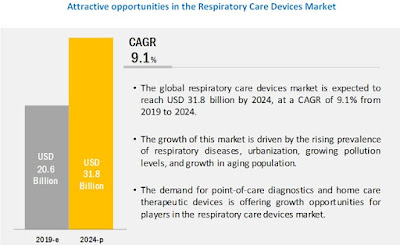The study involved 4 major activities in estimating the current market size for the respiratory care devices market. Exhaustive secondary research was done to collect information on the market as well as its peer and parent markets.
The next step was to validate these findings, assumptions, and sizing with industry experts across the value chain through primary research. Both the top-down and bottom-up approaches were employed to estimate the complete market size. Thereafter, market breakdown and data triangulation were used to estimate the market size of segments and subsegments.
Recent Developments:
- In May 2019, Fisher Paykel (New Zealand) launched a nasal cannula – F&P Optiflow 3S, to strengthen its position in the therapeutic respiratory care devices market.
- In March 2019, ResMed acquired HB Healthcare Safety, a provider of home-based medical equipment for sleep and respiratory care devices.
- In March 2018, Philips opened its first Sleep and Respiratory Education Center in Singapore.
- In May 2019 Masimo Corporation (US) signed an agreement with Shenzhen Mindray Bio-Medical Electronics Co., Ltd. (China) to offer Masimo SET Measure-through Motion and Low Perfusion pulse oximetry in its monitoring devices. Mindray devices equipped with SET will now be available in select countries in Europe, the Middle East, Russia, the Commonwealth of Independent States, and the Asia Pacific (excluding China), including Australia and India.

Expected Revenue Generation:
The respiratory care devices market is projected to reach USD 31.8 billion by 2024 from USD 20.6 billion in 2019, at a CAGR of 9.1%.
Looking out for More Details | Download the PDF Brochure
Major Factors Influencing the Global Industry Growth:
The major factor driving the growth of the respiratory care devices market is the high prevalence of respiratory diseases as a result of the rapid growth in the global geriatric population, high prevalence of tobacco smoking, urbanization and growing levels of pollution, and changing lifestyles.
However, factors such as the presence of an unfavorable reimbursement scenario and the availability of low-cost products from local manufacturers are expected to restrain the growth of this market during the forecast period.
Industry Leaders and Growth Strategies Adopted by Them:
The respiratory care devices market is fragmented in nature, with the top five players accounting for around half of the total market in 2018. There are other smaller and medium-sized players as well, operating at both global and regional levels. The leading market players are based across developed countries such as the US, the Netherlands, New Zealand, and Ireland; however, in the past few years, smaller players have emerged, especially in the Asia Pacific market, competing with global players on the basis of price.
Lucrative growth opportunities in the Asia Pacific market are increasing competition among market players. Companies are also focusing on R&D to add innovative technologies and products to their portfolios, which, in turn, helps them to strengthen their presence in respective markets.
Some of the other leading players competing in this market are Philips Healthcare (Netherlands), ResMed Inc. (US), Medtronic plc (Ireland), Masimo Corporation (US), Fisher & Paykel Healthcare Corporation Limited (New Zealand), Chart Industries (US), Drager AG (Germany), Invacare Corporation (US), Getinge AB (Sweden), Air Liquide (France), Hamilton Medical AG (Switzerland), Vyaire Medical (US), GE Healthcare (US), Nonin Medical Inc. (US), Apex Medical Corp. (Taiwan), Smiths Group (UK), Omron Healthcare Inc. (US), Allied Healthcare Products, Inc. (US), Teleflex Incorporated (US), and DeVilbiss Healthcare LLC (US).
Read More@
https://www.marketsandmarkets.com/PressReleases/respiratory-care-devices.asp